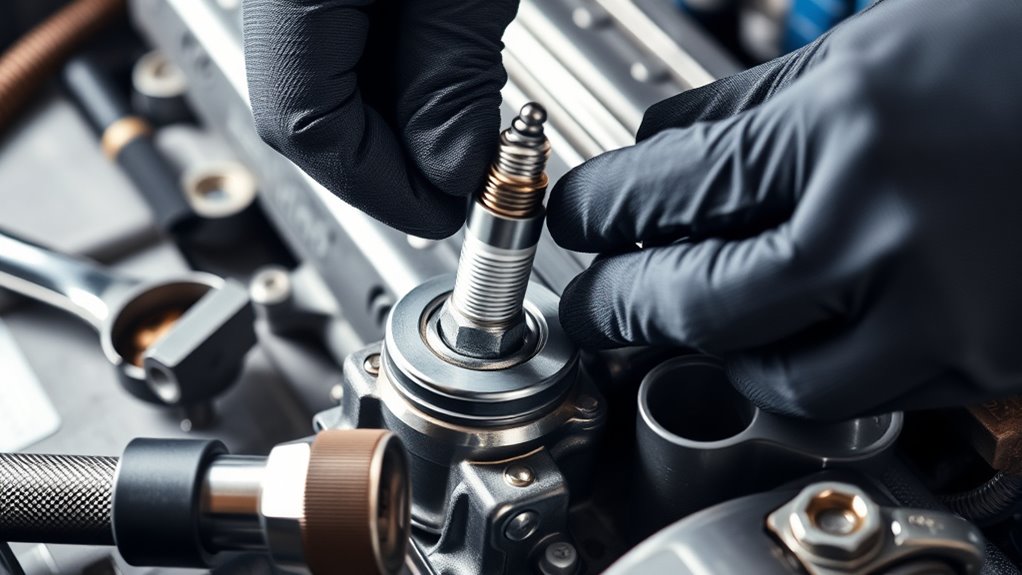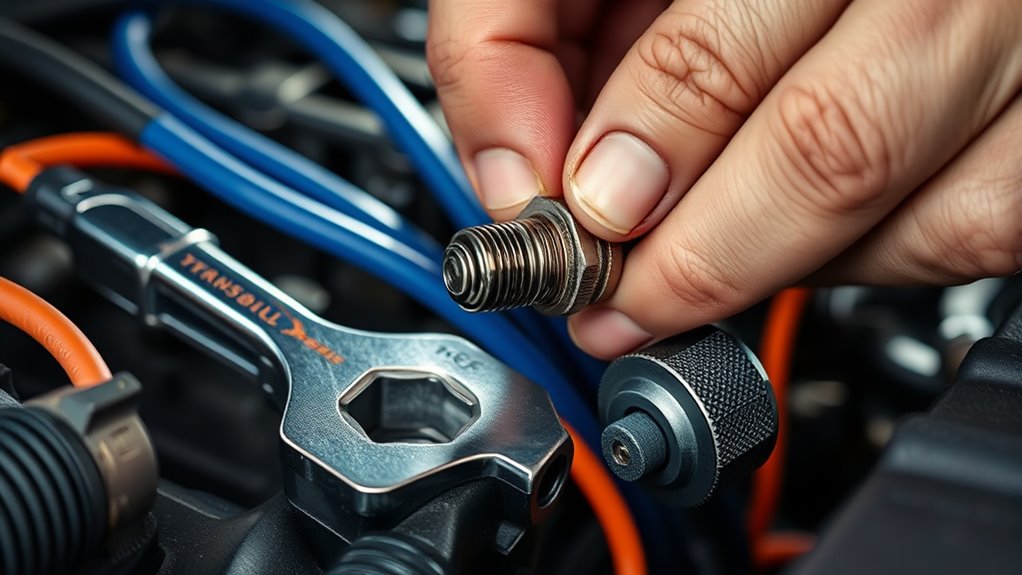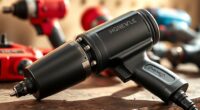When replacing spark plugs, you’ll need a socket wrench, a spark plug socket with a rubber insert, an extension bar, and a torque wrench for proper tightening. Carefully disconnect the ignition coil or wire, remove the old plug, and check the gap on the new one using a gap gauge. Hand-thread the new plug to avoid cross-threading, tighten to the recommended torque, and reassemble. Keep going to discover more helpful tips and tricks for a smooth replacement process.
Key Takeaways
- Use a socket wrench with a spark plug socket and extension for easy removal and installation.
- Disconnect the negative battery terminal to ensure safety before starting.
- Check and set the correct gap on new spark plugs using a gap or feeler gauge.
- Tighten spark plugs to the manufacturer’s specified torque with a torque wrench.
- Reassemble all components, reconnect the battery, and test the engine for smooth operation.

Replacing spark plugs is a crucial maintenance task that can improve your vehicle’s performance and fuel efficiency. When done correctly, it guarantees that your ignition system functions smoothly, leading to better engine performance overall. Spark plugs are essential components that ignite the fuel-air mixture in your engine cylinders, and worn or faulty plugs can cause misfires, rough idling, and reduced power. By replacing them with the right tools and techniques, you keep your vehicle running efficiently and prevent more costly repairs down the line.
Replacing spark plugs boosts performance and fuel efficiency, ensuring smooth ignition and preventing costly engine issues.
Before you start, gather the necessary tools. You’ll need a socket wrench with the appropriate size socket, usually 5/8 inch or 13/16 inch depending on your vehicle. A spark plug socket, which often has a rubber insert, helps grip the plug securely without damaging it. An extension bar can make reaching plugs easier if they’re tucked deep in the engine bay. You might also want a torque wrench to ensure you tighten the new plugs to the manufacturer’s specifications, preventing over-tightening or under-tightening. Additionally, keep a gap gauge or feeler gauge handy to verify that the new spark plugs are properly gapped, as incorrect gaps can impair ignition efficiency and engine performance.
When you’re ready, turn off your vehicle and disconnect the negative terminal of the battery for safety. Locate the spark plugs, which are usually visible on the top or side of the engine, often covered by plastic engine covers that you may need to remove. Carefully disconnect the ignition coil or spark plug wire from each plug. Use your socket wrench and extension to unscrew the old spark plug, turning counterclockwise. Be gentle to avoid damaging the threads in the cylinder head. Once removed, inspect the old plugs for signs of wear, such as carbon buildup or electrode erosion, which can indicate underlying issues in the ignition system. Understanding ignition system components can help diagnose potential problems early.
Before installing the new spark plugs, check and set the correct gap according to your vehicle’s specifications. Carefully thread the new plug by hand to prevent cross-threading, then tighten it with your torque wrench to the recommended torque. Reconnect the ignition coil or spark plug wire securely, ensuring a snug fit. Repeat this process for each spark plug. After completing the replacements, reconnect the negative battery terminal, start your engine, and listen for smooth operation. Well-maintained spark plugs contribute greatly to peak ignition system function, which in turn enhances your engine’s performance, fuel economy, and overall reliability. Regularly replacing your spark plugs as part of your vehicle’s maintenance routine keeps your engine running at its best.
Frequently Asked Questions
How Often Should I Replace My Spark Plugs?
You should replace your spark plugs every 30,000 to 50,000 miles, depending on your vehicle’s maintenance schedule. Regular replacement helps maintain peak fuel efficiency and engine performance. Check your owner’s manual for specific recommendations, as some newer models may go longer between changes. Keeping up with this schedule prevents misfires, improves acceleration, and ensures your engine runs smoothly, saving you money on repairs and fuel in the long run.
Can I Replace Spark Plugs Myself or Should I Hire a Mechanic?
You can definitely replace spark plugs yourself, saving money and gaining confidence with DIY tips, but if you’re unsure or uncomfortable, professional services guarantee the job’s done right. It’s like the thrill of fixing your car versus the peace of mind from expert help. Consider your mechanical skills and comfort level; if needed, hire a mechanic to avoid potential damage or misfire, and enjoy a smoother ride.
What Are Signs My Spark Plugs Need Replacing?
If your ignition system isn’t firing properly, you might notice your engine misfiring, rough idling, or difficulty starting. You may also see reduced fuel efficiency and sluggish acceleration, which indicate your spark plugs could be worn out. When these signs appear, it’s time to replace your spark plugs to restore peak engine performance and guarantee your ignition system runs smoothly. Regular maintenance keeps your vehicle running reliably.
Are There Different Types of Spark Plugs for My Vehicle?
Think of spark plugs as the shoes of your engine—they come in different styles for different needs. Yes, there are various types, including specialty spark plugs designed for high performance or specific conditions. They differ in spark plug materials like copper, platinum, or iridium, which affect durability and efficiency. Choosing the right one depends on your vehicle’s make and driving habits, ensuring smooth rides and reliable starts.
How Do I Choose the Right Spark Plug Gap?
To select the right spark plug gap, you need to verify your vehicle’s gap measurement specifications, usually found in your owner’s manual or on the engine’s tag. Use a feeler gauge to measure the spark plug gap accurately, guaranteeing it matches the recommended gap for spark plug compatibility. Properly gapped plugs ensure peak engine performance, fuel efficiency, and smooth operation, so don’t skip this critical step.
Conclusion
Think of replacing spark plugs as giving your engine a fresh heartbeat. When you carefully select the right tools and follow each step, you’re reigniting its spark and restoring its rhythm. Just like tending a delicate garden, patience and attention to detail nurture smooth performance. With each new plug, you’re planting the seeds for reliable starts and endless journeys. Keep your engine’s pulse strong—because a well-maintained spark is the heartbeat of your drive.









